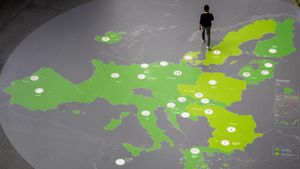Retail sales figures for February showed signs of growth, brushing aside concerns about job cuts and economic slowdown. U.S. retail sales increased by 3% from the previous month, according to data released by the Commerce Department, signaling consumer resilience amid inflationary pressures. This surge is attributed primarily to higher demand for electronics, home improvement goods, and various discretionary items. Analysts had initially predicted only modest growth, adding to discussions about the overall health of the economy.
Experts have pointed out this uptick is significant, especially as it suggests consumers are still willing to spend even as the Federal Reserve's interest rates continue to rise, aimed at curbing inflation. "Consumers have shown remarkable fortitude during these tough economic times, and it's clear their willingness to spend is enduring," said one economic analyst. High inflation, which has squeezed budgets, doesn't seem to be dampening retail enthusiasm just yet.
Yet, contrasting this optimism, new jobless claims released the same week painted another picture. The Labor Department reported first-time unemployment claims rose to 264,000, marking the highest level since October. This development has sparked discussions among economists about possible looming economic troubles. The uptick is seen as concerning by some, potentially indicating larger job cuts are on the horizon.
Labor analysts are closely watching these jobless claims, as they can be seen as leading indicators of the labor market’s health. Some experts suggest this rise might correlate with concerns within specific industries, particularly technology and retail, where layoffs have become somewhat of a trend. Many companies are tightening their belts, trimming their workforces to cope with economic uncertainty.
While the retail sales figures are positive, the rising jobless claims have led to debates about America’s economic stability. Rising unemployment coupled with strong retail sales is somewhat paradoxical and economists are intrigued by what this means for the overall economy. "You can’t have strong retail sales rates without sustainable job growth; it's just not sustainable," stated another analyst during a recent economic summit.
The push and pull between these two economic indicators continues to capture the attention of policymakers, as the Fed considers its next moves. Some analysts expect these conflicting signals may pressure the Federal Reserve to reconsider its stance on interest rate hikes. Higher interest rates could potentially strain consumer spending even more, creating what some fear could be a negative feedback loop for the economy.
Interestingly, the retail sector isn't entirely oblivious to these job market fluctuations. Retailers are still hiring but at different paces, and many are beginning to utilize automation and technology to fill some roles. Some firms are shifting focus toward building sustainable workforces without overextending themselves financially by hiring too many employees too quickly.
This mixed economic environment complicates things. With rising prices pushing consumers to be more selective about their spending, the increase can hardly be viewed as unequivocal good news for retailers. Experts warn of caution around predicting trends based solely on one month's figures. For example, February’s results may be skewed due to seasonal factors or specific promotional events like Valentine's Day and early spring discounts.
Despite this, there's still insufficient evidence to predict these patterns will lead to larger economic troubles. Most economists agree the labor market remains historically strong, notwithstanding fluctuations. The U.S. unemployment rate remained at near-record lows in February, around 3.6%, even as companies navigate their unique challenges.
Younger consumers, particularly those with digital shopping habits, continue to exert significant influence. Their spending behavior suggests they are more accustomed to making purchases online, aiming to snag good deals. Hence, retail innovations like adaptive merchandising aimed at catering to these trends are likely to play pivotal roles.
How these factors evolve remains uncertain, but economists feel there is a trickiness to balancing consumer spending, inflation, job stability, and wage growth. "These interconnected dynamics will guide us as we enter the spring months, and I expect more fluctuations as we go through the year," concluded one economist. The path forward is not completely clear but keeping an eye on these competing signals will be imperative.
Overall, upcoming months will be key, not just for retail and job claims but also for evaluating the overall economic outlook as America continues grappling with the dual challenges of consumer spending habits and job market shifts within the 2024 economic environment.



